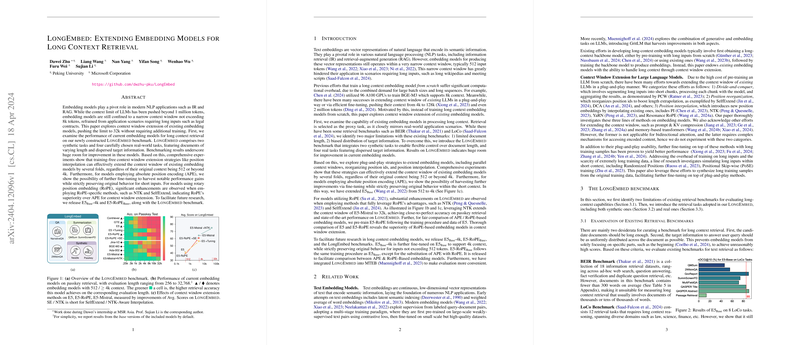Extending Context Window in Embedding Models for Enhanced Long Input Processing
Introduction and Motivation
Embedding models are fundamental to various NLP applications, yet they have traditionally been limited by narrow context windows. This paper sets forth a comprehensive exploration into strategies for extending the context windows of existing embedding models without necessitating retraining. The focus is on enhancing performance for long input scenarios, such as lengthy documents or detailed contracts, where traditional models falter due to their typical limitation of 512 to 8k tokens.
Benchmarking Current Models
The paper introduces LongEmbed, a new benchmark designed to critically assess the performance of embedding models across extended contexts. LongEmbed includes both synthetic and real-world tasks tailored to challenge the models with inputs significantly exceeding traditional lengths. The results from these benchmarks highlighted considerable room for improvement, as current models struggled with effectively managing longer contexts.
Strategies for Context Extension
Several methodologies were tested for extending the operational range of these models:
- Position Interpolation and Reorganization: Methods like parallel context windows and position interpolation proved effective across various models, multiplying the effective context window several-fold.
- RoPE and APE Comparisons: Distinct strategies were tailored for models based on their position encoding methodologies — Absolute Position Encoding (APE) and Rotary Position Embedding (RoPE). For APE, techniques like position interpolation allowed for extended context processing without additional training. RoPE models, however, benefited significantly from RoPE-specific methods like NTK (Neural Tangent Kernel-aware Interpolation) and SelfExtend, which leverage their inherent handling of relative positions.
Empirical Findings
The empirical studies conducted showed remarkable results:
- APE-based models could handle increased token loads with extended position embedding techniques, with fine-tuning offering further benefits while preserving performance on shorter inputs.
- RoPE-based models saw substantial improvements using RoPE-specific extensions, demonstrating their potential for managing even longer inputs effectively — for instance, extending E5-Mistral's context window to 32k tokens improved performance metrics significantly.
Implications and Future Work
The insights from this paper suggest substantial implications for the development of more efficient and capable embedding models. The demonstrated superiority of RoPE in handling extended contexts proposes a shift in model design preferences for future embedding tasks. Moreover, the methodologies and new benchmark introduced here provide a foundation for further research into embedding model enhancements.
The research also sets the stage for exploring additional strategies in context window extension and fine-tuning, and stresses the benefit of shared benchmarks like LongEmbed for consistent evaluation and comparison of future models.
Conclusion
Overall, this work not only advances our understanding of how embedding models can be adapted to manage longer contexts effectively but also underlines the importance of model and methodology choices in achieving high performance in long-input scenarios. Researchers are encouraged to leverage the findings and tools made available through this paper to propel the capabilities of NLP applications further.
